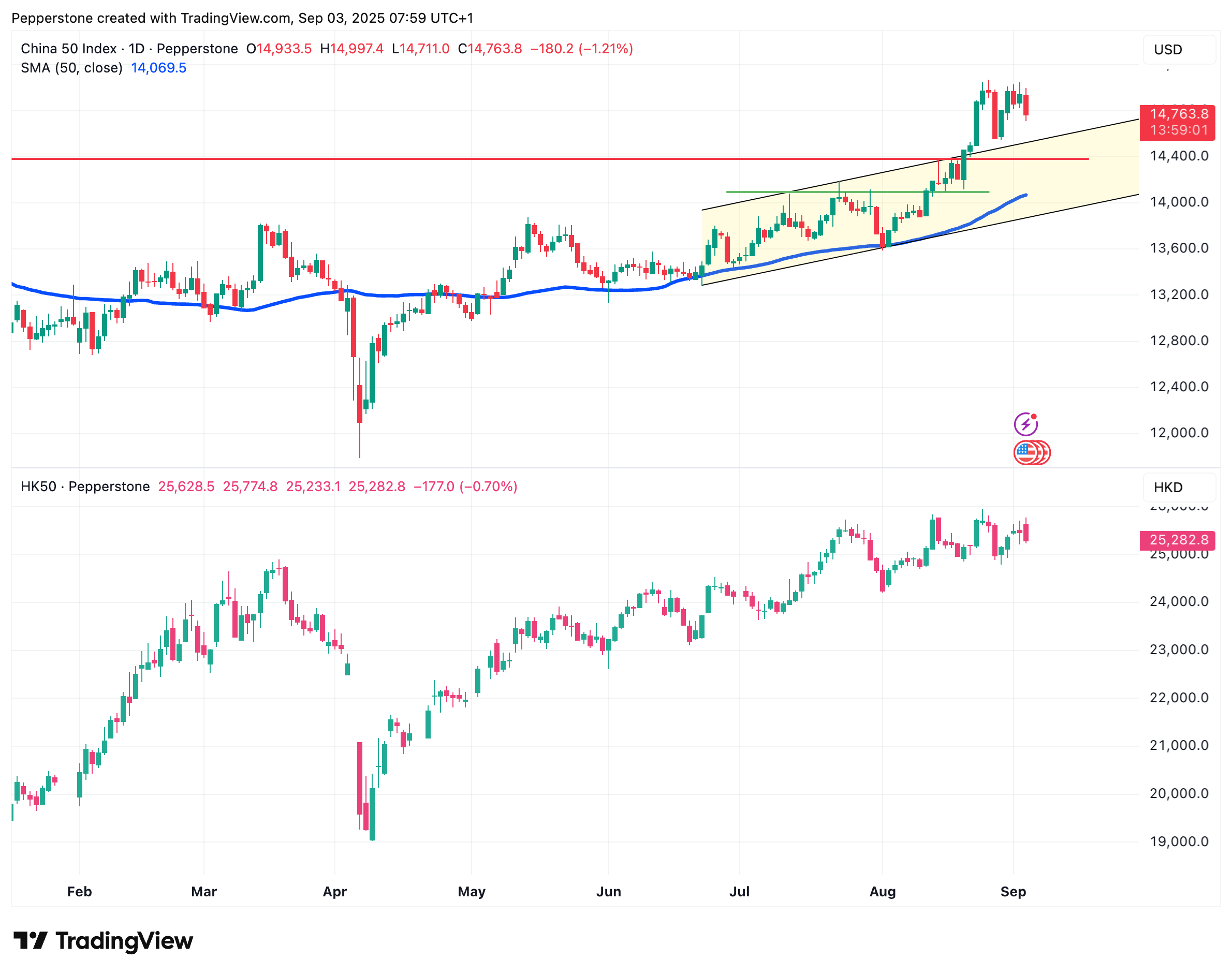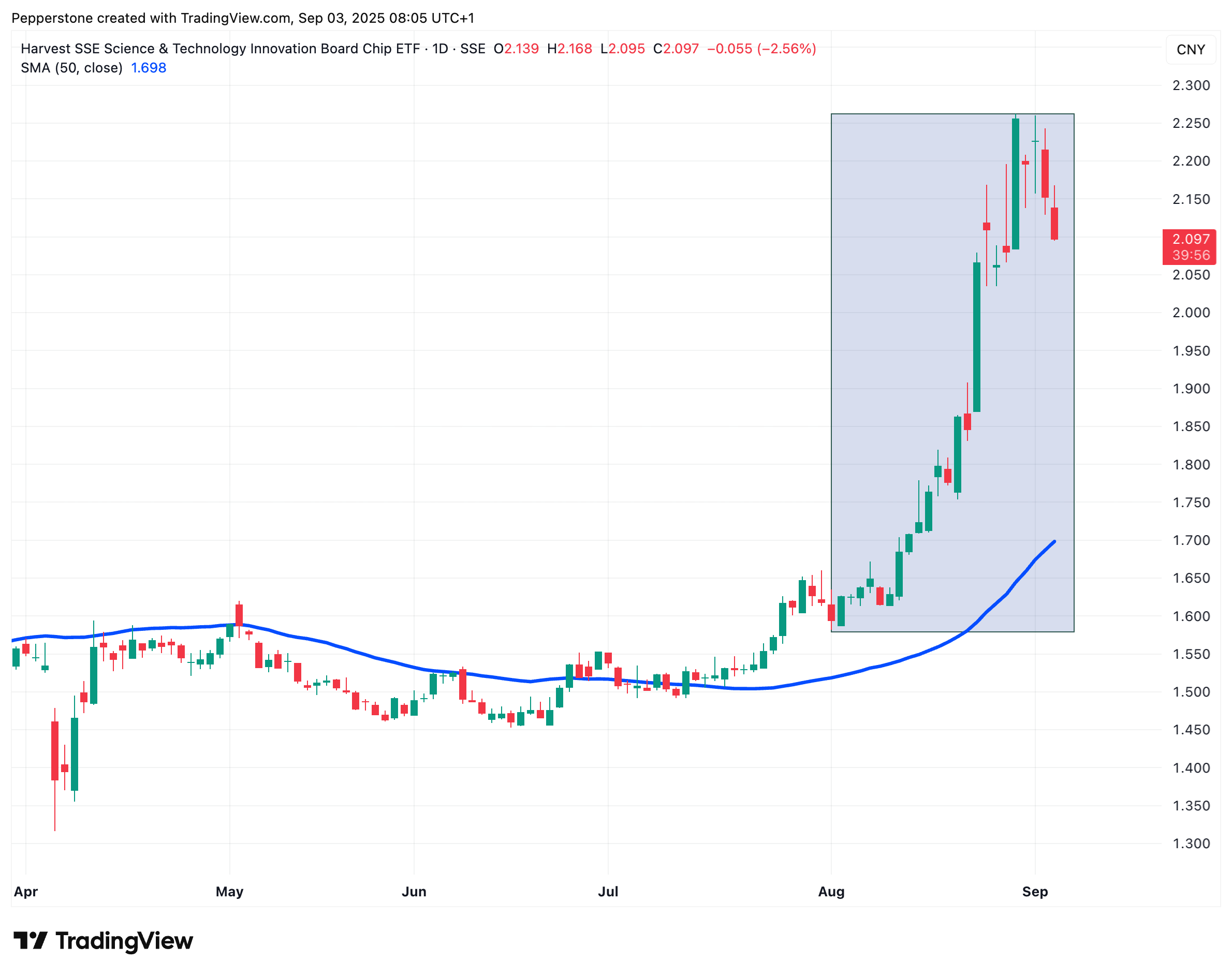Spread bets and CFDs are complex instruments and come with a high risk of losing money rapidly due to leverage. 72% of retail investor accounts lose money when trading spread bets and CFDs with this provider. You should consider whether you understand how spread bets and CFDs work, and whether you can afford to take the high risk of losing your money.
- English (UK)
Amid geopolitical uncertainty, the Fed’s independence questions, and ambiguity around rate cuts, U.S. equities have been oscillating at high levels, with the Nasdaq showing signs of hesitation. By contrast, Chinese and Hong Kong markets have quietly staged an independent rally, led by the tech sector.
The CN50 has risen in 10 of the past 11 weeks, while the CSI 300 recorded gains in 9 of the past 10 weeks, with trading activity significantly higher. In A-shares, Cambricon briefly surpassed Kweichow Moutai in market cap, SMIC hit an all-time high, and Industrial Fulian joined the “trillion club.”
Hong Kong equities also started September strongly, with Alibaba, Baidu, and JD all climbing, and Alibaba’s stock opening up over 18% on its first trading day.

The key question is no longer whether the rally exists, but how far it can go and how to participate. In a hesitant global market, Chinese tech stocks appear to be the new offensive direction.
Traders are also asking whether CN50 and HK50 could serve as a “cost-effective Nasdaq alternative,” and whether the rapid price gains reflect real technological progress or simply overextended expectations.
Rally Drivers: Innovation Meets Policy Push
Since August, the A-share STAR Market chip index has surged over 40%. Among 58 semiconductor companies, 40 have reported earnings growth, and 17 saw net profits double year-on-year. This rally is not driven by a single event but by the convergence of multiple factors.

Technological breakthroughs are particularly critical. The release of DeepSeek-V3.1 has strengthened market confidence in the domestic AI computing ecosystem. Its FP8 precision aligns closely with domestic chip architecture, boosting expectations for local substitution. Meanwhile, AI chips, CPO, PCBs, and liquid cooling hardware chains are heating up, with momentum spreading from single points to broader computing, electronics, and communications sectors, driving systemic gains across the indices.
Policy signals are equally clear. China’s State Council recently issued the “Action Plan for Deepening ‘AI+’ Implementation,” targeting over 90% AI adoption by 2030, supplemented by R&D funding and capital market support. Against the backdrop of U.S.-China competition, tech is no longer just a market trend but a policy-driven long-term theme, with semiconductors and hard tech receiving both institutional and financial backing.
Representative Names: From Established Leaders to Rising Stars
At the stock level, this logic is already evident in corporate earnings. Alibaba’s Q1 revenue rose 10% year-on-year, with net profit up 76%, and Alibaba Cloud rebounded sharply, with AI products maintaining triple-digit growth for eight consecutive quarters. Tencent’s stock reclaimed 600 HKD, with management emphasizing continued AI investment, already translating into efficiency and revenue gains across gaming, advertising, and cloud services.
Hardware companies benefit more directly. SMIC and Industrial Fulian have been significantly boosted by capex expansion and domestic substitution progress, solidifying their positions in the supply chain.
Cambricon has emerged as a hot target. Since July, its stock has risen nearly 94%, and H1 2025 revenue increased 43-fold year-on-year, making it the market’s new favorite. This transition from established players to rising stars adds depth to the current rally.
Trade Easing and Growth Support
Beyond individual companies, a softer external environment is also supporting the rally. U.S.-China trade tensions have temporarily eased, with concessions including China allowing rare earth exports and the U.S. partially relaxing tech export restrictions. This helps improve risk sentiment and reduce valuation discounts.
Global growth remains subdued, with the World Bank projecting 2.3% in 2025, one of the lowest non-crisis years in two decades, yet China’s growth expectation remains around 4.5%. Greater macro and policy predictability strengthens the pricing anchor for tech-driven equities.
As the tech theme gains traction, Wall Street is also looking internally at the structure of the Chinese market, using the “Prominent 10” as a window into market breadth. Unlike the U.S. “Magnificent 7” tech giants, these 10 companies span e-commerce, content, healthcare, smartphones, and EVs, collectively accounting for just 17% of China’s total market cap. This structural diversification allows rotation across “Tech – Consumption - Manufacturing” curves, offering richer alpha opportunities beyond tech alone.
Challenges: Valuation, Execution, and External Risks
Yet this tech rally is not without challenges. High valuations are a reality: the STAR 50 index trades at 180x P/E, near a four-year high, making the market highly sensitive to earnings delivery. Any hiccup in orders, yield, shipments, or cash collection could trigger rapid valuation corrections.
Timing mismatches in the AI cycle remain a risk. Accelerated capex may not immediately translate into revenue if internet giants don’t proportionally increase domestic chip procurement, or if upstream capacity ramps slower than expected, volatility is likely.
External uncertainties persist as well. Trade regulations, semiconductor export controls, exchange rates, and U.S. Treasury yields could transmit risk appetite shifts and valuation adjustments into the tech sector.
Beyond the Hype: Sustainability & Execution Matter
Overall, viewing CN50 and HK50 as simple “Nasdaq substitutes” is incomplete. While Nasdaq represents “general platforms and ecosystem output,” the logic for Chinese and Hong Kong tech lies in policy backing, application rollout, and domestic substitution.
In the short term, with dual policy and industrial support, tech-driven indices have upward paths of least resistance, though high valuations imply greater volatility. Traders should focus on domestic chip procurement ratios, AI computing rollout, order fulfillment speed, and ETF creation/redemption flows - key indicators to gauge rally sustainability and potential pullbacks.
Ultimately, whether CN50 and HK50 can continue higher depends not just on narrative potential but on timely delivery of earnings and cash flow. What the market really cares about is whether China’s AI can move from “innovation” to “P&L”.
The material provided here has not been prepared in accordance with legal requirements designed to promote the independence of investment research and as such is considered to be a marketing communication. Whilst it is not subject to any prohibition on dealing ahead of the dissemination of investment research we will not seek to take any advantage before providing it to our clients.
Pepperstone doesn’t represent that the material provided here is accurate, current or complete, and therefore shouldn’t be relied upon as such. The information, whether from a third party or not, isn’t to be considered as a recommendation; or an offer to buy or sell; or the solicitation of an offer to buy or sell any security, financial product or instrument; or to participate in any particular trading strategy. It does not take into account readers’ financial situation or investment objectives. We advise any readers of this content to seek their own advice. Without the approval of Pepperstone, reproduction or redistribution of this information isn’t permitted.
.jpg)